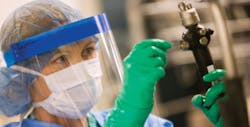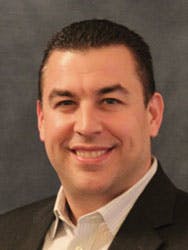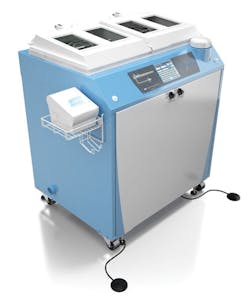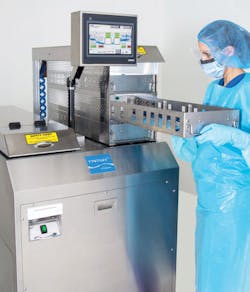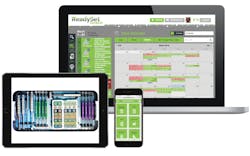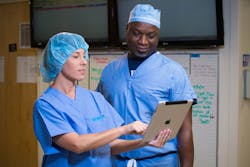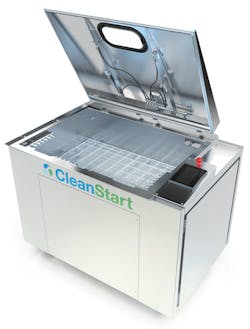In healthcare the concept of surgical instrument sterility is the epitome of clean and there are a variety of complex processes and equipment available to facilitate sterilization. On the other hand, the act of cleaning instruments is often viewed as the ugly stepsister to sterilization — the “drudge work” that requires fewer technical skills. Consequently, those central sterile/sterile processing department (CS/SPD) professionals with greater experience and certification are typically assigned to sterilization and assembly, while entry-level technicians are assigned to decontamination and cleaning.
But in speaking with CS/SPD professionals, the cleaning process is not only technically complex but also a critical component to delivering safe and effective surgical instruments to the operating room. As the instruments themselves become more complicated, so do the processes and tools needed to clean them.
“I believe decontamination and cleaning are the most critical parts of the entire CS/SPD process because of the science involved and the risks for cross-contamination and microbial growth that are presented when individuals take short cuts,” said Angela Lewellyn LPN, CHL, CRCST, CSPDT, Executive Director of SPD and Surgical Support, Advantage Support Services. “The CS/SPD hierarchy seems upside down to me and I think it should be switched so that those technicians responsible for decontam and cleaning become the highest on the employee ladder and pay scale.”
In this article we present insights from CS/SPD professionals on the challenges they face in cleaning surgical instruments, offer best practices throughout the cleaning workflow — from point of use (POU) cleaning in the operating room (OR) through to post washing inspection, and present some of the latest products designed to promote effectiveness at every step of the process.
It all starts in the OR
A common frustration among CS/SPD professionals is the unwillingness or inability of OR staff to perform instrument pre-cleaning, and the state in which they receive instruments from ORs into their departments.
Lewellyn, who has 20 years experience in operating rooms as a surgical nurse and in the CS/SPD, says pre-cleaning of instruments by surgical staff was common practice two decades ago, but when she and her partner conduct CS/SPD assessments today they find this is no longer the case.
“When we conduct an assessment for a health system we always start with the OR, interviewing the surgical tech first to see what he/she does throughout a case to reduce the amount of gross bioburden on instruments,” said Lewellyn. “I ask if they have labeled sterile water somewhere in the room and a way to remove gross soil at the field. When I worked in the OR, every time a surgeon would hand me an instrument I would wipe it off — it took less than half a second to do. But we find this really isn’t practiced anymore.”
To emphasize the need for effective cleaning originating with the OR, Thomas Overbey, Marketing Director, Ultra Clean Systems, points to a New York Times article published on November 22, 2017, entitled: Abnormal Proteins Discovered in Skin of Patients With Rare Brain Disease.1 The article revealed a study in which 23 patients who died from Creutzfeldt-Jakob disease (CJD) were found to have prions in their skin. The article author states:
“The presence of prions in the skin also raises unsettling questions about whether medical instruments could become contaminated even during surgery that does not involve the brain and then spread the disease to other patients. The prions stick to stainless steel and are notoriously hard to destroy.”
“With the increasing spread of the prion disease called chronic wasting disease (CWD), studies have shown that it is possible for CWD to cross over into the human population,” said Overbey. “Will this lead to a day when all patients will be tested for prion disease? The concern with proper and thorough instrument cleaning is always at the forefront and this should be the absolute case with the benefits from originating the cleaning process in the OR. Preparation for decontamination of instruments should begin at the point of use.”
Tips for compliance
David Jagrosse, CSS Supervisor for Middlesex Hospital, notes that when The Joint Commission recently visited his facility the inspectors were focused on point-of-use cleaning and transport of surgical instruments from the OR to the CS/SPD.
“When we in CS/SPD ask OR staff to perform pre-cleaning they often push back and say cleaning is our job,” said Jagrosse, who is the Immediate Past President of International Association Of Healthcare Central Service Materiel Management (IAHCSMM), and an Association for the Advancement of Medical Instrumentation (AAMI) ST79 Committee Member. “You see some serious compliance once it is an outside agency enforcing it though. It’s too bad that more ORs don’t realize the importance of POU cleaning and aren’t more preemptive with it.”
When asked for tips on enforcing POU cleaning in the OR, Jagrosse suggests that CS/SPD staff present both AAMI ST79 and the Association of periOperative Registered Nurses (AORN) Guideline for cleaning and care of surgical instrument document so that OR staff can clearly see the importance of POU cleaning in “their own language.”
A more hands-on tactical approach that Jagrosse takes is placing a small bottle (4 oz) of pre-spray enzymatic on every case cart so that it is readily available to OR staff during each case.
“When you have a larger bottle in the room the OR staff has to wipe it down as part of the room turnover so we send up this one shot bottle — or multiple bottles if it is a larger case,” said Jagrosse. “It is right there on the case cart ready to go. I’ve found this approach to be very effective.”
With regards to enforcement, Jagrosse says his facility has considered making POU cleaning one of their new quality measures stating, “once it is reported to the quality department you can’t just sweep it under the rug you have that report out so it puts a little more pressure on compliance.”
Jagrosse notes how use of the Getinge T-DOC sterile solution has given him and his team the hard data they need to show OR leaders POU cleaning compliance rates, and the leverage to address compliance failures.
“If instruments come down from the OR into decontam and have not been pretreated then we can scan them and capture that information,” said Jagrosse. “When I have my weekly meeting with the OR manager I say out of the 100 cases this week, 29 case carts came down with no pretreatment. Clinicians are data driven so data is key. It is much more powerful to have those numbers versus just saying ‘nobody is spraying the instruments.’”
The Getinge T-DOC Risk Management Software for central sterile (CS) and hospital administrators helps turn information into human understanding — the key to continual improvement and the elimination of the clinical, legal and operational risks associated with sterile processing. T-DOC introduces an unprecedented level of accountability and administrative control into sterile and surgical workflows to ensure vital instruments and goods will always be available when and where they are needed. Along the way, T-DOC can help CS staff avoid making critical errors where a single mistake or delay can have serious consequences for surgeons and patients, alike.
When Lewellyn and her team at Advantage Support Services are conducting an on-site hospital training, they team up a CS/SPD educator with an OR educator to help educate OR staff on the importance of reducing gross bioburden at the point of use. They also assign a CS/SPD expert to observe a case in the OR from beginning to end so that he/she can offer the OR staff tips for POU cleaning.
Pre-treatment product selection
While pre-treatment enzymes used at the point of use are beneficial to the cleaning process, helping those in decontamination remove gross debris, they can cause problems further down the workflow chain, Jagrosse explains. He says a facility must ensure its chosen pre-treatment product is compatible with its washers, and in some cases rinse this product off from the instruments prior to washing.
“There are some instrument sets that could potentially go directly to the washer because they don’t require any pre cleaning in the sinks or anything else that we do on the back end,” said Jagrosse. “For these instruments you need to program a cold water rinse to wash away blood and any excess product because if you were to just fill the chamber with water and go directly to the wash cycle then it will over-foam and cancel the cycle.”
Transport
Another key area in the cleaning process that can be overlooked is the transport of dirty surgical instruments from the OR to the CS/SPD. When mismanaged, this process presents the risk for cross-contamination, delays and lost instruments.
“One challenge that CS/SPD staffs often face in order to achieve the successful decontamination of surgical instrumentation is the ability to receive instruments from the operating room in a timely manner,” said Todd Campbell, President of TBJ. “If surgical instrumentation is not received from the OR in a timely manner after completion of a surgical procedure, blood, body fluids and tissue will dry on the instruments making the technicians job of manually pre-cleaning instruments much more difficult and time consuming.”
Lawayne Perkins, CDA, CRCST, CHL National Project Manager with Advantage Support Services, describes CS/SPD professionals involved in transport as a “forgotten gem” because they play a critical role as the first visual inspection of instruments before entering decontamination. He believes healthcare facilities should place a greater emphasis on this role, stating:
“Their insights are a vital communicative tool for the decontam because they can see if something is grossly soiled or if instruments are disorganized,” said Perkins. “In facilities where they must push a case cart through hallways in order to get it from the OR to decontam, they have the opportunity to assess the safety of the cart (e.g., it is locked, does not contain liquid) thereby protecting staff and patients from cross contamination. They can also play a role in protecting instruments from damage and preventing instruments lost during transport.”
Decontamination details
Perkins notes that once a case cart arrives in decontamination there is a second critical opportunity for inspection — before the tech even begins the decontam process. He explains that if an issue is found, the CS/SPD can use it as a teaching opportunity for OR staff.
“While the rules and regulations are clearly defined on what to do once we get these dirty instruments into our cleaning and disinfection station, they are pretty light about receipt into decontam — the pre-step before step one,” said Perkins. “A visual inspection in decontam allows a CS/SPD tech to identify problems stemming back to the OR (such as sharps in the case cart). It is important that the facility’s policies and procedures for the reprocessing of surgical instruments be validated by best practice guidelines and it is also good practice to reference your source of information within the body of the policy or on a reference page. Intra communication between the CS/SPD and OR teams to manage that process right there at that moment is so vital.”
The right tools for the job
Jagrosse says that even a few years ago the number of tools for decontamination were limited, but today CS/SPD professionals have a broad range of equipment at their disposal to comply with more complex instrumentation and increasingly stringent instructions for use (IFUs).
“Times have changed and gone are the days of having a one size fits all process for decontam,” said Jagrosse. “We used to just have a brush hanging up on the wall in decontam and you would use that brush for everything — whether the lumen was 2mm wide or 10mm wide. Today everything is device-driven through the IFU and must be very precise — if there is a 2mm channel you need a 2mm brush. The whole process has really changed and that may require more staffing as devices get more complex.”
TBJ has introduced its new Hydro-Force rinse system to greatly assist technicians in the pre-cleaning and initial removal of gross debris of material from instruments after surgery. The Hydro-Force rinse system option enables technicians to place grossly soiled trays of instruments in TBJ’s pre-cleaning sinks and let the sink do the work for them. Water is automatically recirculated in the sink basin to create a gentle turbulence and remove gross soil and debris for a pre-programmed amount of time at the push of a button. Additional features include automatic sink basin filling, detergent injection and automatic draining.
Modular instruments
Chuck DePreker, Operating Room/Sterile Processing Supply Chain Manager at Eisenhower Army Medical Center, explains that even if an instrument set comes straight to decontamination from the point of use, the CS/SPD tech in decontamination must take apart any modular instruments and clean them in that state before running them through the normal established steps that lead to the thermal disinfecting washer.
“I can’t stress enough how imperative it is to take apart a modular instrument and run it through the wash process un-assembled prior to receipt in assembly,” says DePreker. “The tech also must probe and flush channels and instruments with lumens. We are fortunate enough to have a high pressure hose attachment we can attach to our sink faucet along with forced air from the facility’s supported nitrogen source.”
“The complexity of instrument designs and correctly following the many IFUs are the biggest challenges CS/SPD professionals face in effectively cleaning instruments prior to sterilization,” said Alicia Diaz, Product/Market Manager, Marketing and Product Management for BD. “Instruments that can be disassembled to aid in cleanability are a great way to help improve the cleaning process. To help in the cleaning and sterilization process, V. Mueller has designed several of their kerrison and Snowden Pencer laparoscopic instruments to feature a take apart design.”
Snowden Pencer 3-mm laparoscopic instruments can be disassembled for enhancing cleaning and sterility goals. Assembly and disassembly is quick and intuitive, allowing for easy inspection during cleaning to help support sterility initiatives. The two-piece 3 mm microlaparoscopic portfolio uses the same ergonomic handles as the company’s three-piece 5 mm and 10 mm instruments for a truly integrated, versatile portfolio of modular laparoscopic instruments.
Is it really clean?
According to Evan Trosvik, CRCST at Maple Grove Hospital, a critical step in the cleaning process during decontamination is to visually inspect each instrument one at a time before they go into a washer. Although it seems like common sense, Trosvik says this step is sometimes skipped due to time restraints, and productivity expectations placed on CS/SPD staff.
“There have been times where an instrument goes through a washer that has passed all of its verification tests but upon visual inspection it is completely soiled,” said Trosvik. “When I’m training techs I tell them — yes a washer can blow paint off a wall — but don’t rely on it to get instruments clean. I always make sure everything looks clean before I even put it into the washer. It is time consuming and unfortunately we are not always given the time that we need to do it properly but it is imperative for the safety of our patients.”
It’s a wash
As CS/SPD professionals are required to process a higher volume of more complex instruments in an efficient and effective manner, they need automated washer/disinfector technology to meet this demand. Jagrosse compares the process of loading and unloading washers to conducting a symphony, with technicians carefully orchestrating each step based on wash cycle times.
“The washers typically take 20 to 40 minutes so once you load them you have to then fall back on the instruments that need a lot of hand cleaning,” said Jagrosse. “Because instruments have become more intricate and the cleaning has become more detailed this process can be overwhelming.”
With regards to detergents, ASTM International has proposed a new standard to help guide the development of detergents that clean medical devices. The practice for characterizing detergents for the cleaning of medical devices (WK58652) is being created by the organization’s committee on soaps and other detergents (D12).2
Maintenance and verification
Because washer-disinfectants are a significant capital investment, DePreker urges CS/SPD professionals, along with the biomedical team, to properly maintain them on a regular basis. Maintenance should also be done at the operator level. For example, DePreker’s team checks the sprayer arms to ensure they are not clogged with debris at both the beginning and end of each shift.
The new American National Standards Institute (ANSI)/Association for the Advancement of Medical Instrumentation (AAMI) ST79:2017 Comprehensive guide to steam sterilization and sterility assurance in health care facilities features a number of revisions impacting the sterile processing of surgical instruments. One notable update with regards to instrument cleaning is the frequency of cleaning verification of mechanical processes. Whereas in the past ANSI/AAMI standards recommended that CS/SPD departments monitor their mechanical cleaning equipment (e.g., automated washer-disinfectors and ultrasonic cleaners) on a weekly basis, the updated guidance recommends daily monitoring.
“We do it every day and while there is a cost tied to it, you can never be too cautious,” said DePreker. “We know when we start our shift that the washers are good, and if there is an issue we can address it.”
Special cleaning considerations: endoscopes, robotics and loaner instruments
“While several organizations have published cleaning guidelines for endoscopes, consistency in following the recommended practices every time continues to be a challenge across sterile processing departments,” said Jeremy Yarwood, Senior Director and Head, Research and Development, Advanced Sterilization Products (ASP) at Johnson & Johnson. “Audits have shown the main cause of endoscopy-associated infections to be the failure of healthcare workers to adhere to proper protocols.”3
“According to the Centers for Disease Control and Prevention (CDC), one way to minimize human error is to utilize an automated endoscope reprocessor (AER),” added Yarwood. “Because these systems automate and standardize several important reprocessing steps, AERs can minimize risks, with the added benefit of reducing personnel exposure to high-level disinfectants or chemical sterilants.”4
Almost ten years ago, ASP introduced the EVOTECH Endoscope Cleaner and Reprocessor (ECR), the first commercially available system that both cleans and high-level disinfects endoscopes using CIDEX OPA Concentrate, a high-level disinfectant and
CIDEZYME XTRA enzymatic detergent. The EVOTECH ECR eliminates the need for manual cleaning of a wide variety of endoscopes when healthcare professionals use one of the cycles that contains a wash stage.5
Because of their complexity, robotic instruments also pose unique challenges to the CS/SPD when it comes to cleaning, and therefore require specific solutions. Ultra Clean Systems TRITON 72 automatic double basin ultrasonic cleaning system with TRT technology is one such solution. It has been validated by Intuitive Surgical to clean da Vinci series robotic instruments. Able to clean up to 40 da Vinci robotic instruments in a single run, this workhorse provides higher throughput in less time, which helps a department run more efficiently. The Triton 72 is the only system featuring ultraviolet water deactivation. The incoming and recirculated water is treated with UV energy to deactivate bacteria and viruses.
Matthew Strunk CRCST, CIS, CHL, Business Development Manager at ReadySet Surgical, comments on another challenge facing CS/SPD professionals — the processing of receiving and cleaning loaner instruments prior to surgery. According to Strunk, managing loaners can be a much more difficult task than managing hospital owned inventory. He notes how instrumentation that hospitals do not own has negatively impacted the workflow efficiency in CS/SPDs across the country for many years.
“Loaner deliveries that arrive late, exceed the number of trays the facility was expecting, or are not accompanied by the proper documentation are just a few of the many issues being faced by healthcare professionals everyday,” said Strunk. “We’ve all come across a set of loaner instruments with no documentation that we’ve never seen before. You have no idea what items need to be disassembled, should it be run in an Ultrasonic, can it safely be processed in the washer/disinfector, what type of sterilization parameters are required?”
“New technology now allows for vendors to provide delivery details, supporting documentation at the tray level, and even images all in an electronic format,” Strunk adds. “This critical information helps drive efficiency, accountability, and most importantly patient safety.”
Measuring and tracking performance to standardize best practices
According to Linda Homan, RN, BSN, CIC, Senior Manager, Clinical & Professional Service for Ecolab, CS/SPDs are hard pressed to implement quality initiatives to drive continuous improvement, promote patient safety, and provide the same standard of care for every patient. She points out how facilities may have components for process improvement in place, such as checklists, self-audits, and training programs for staff. However, many facilities do not have the tools to visibly demonstrate what they are doing well, help identify opportunities for improvement, identify training needs of their staff and resources needed to adopt industry best practice.
“At Ecolab, we believe regular audits on the processes and practices in CS/SPD are essential for patient safety, continuous process improvement, and preparation for accreditation surveys,” said Homan. “Performing routine audits helps assess risk, identifies reprocessing gaps/training opportunities, and ensures improvement plans for instrument cleaning, a process that is highly impacted by human factors.”
Beginning in 2017, Ecolab began offering an audit service, as part of the Ecolab Central Sterile Program. Delivered by skilled Ecolab associates and technical experts, it is an innovative tool that measures compliance of critical factors of the cleaning process. A dashboard report provides a total compliance score, compliance by major area and trend analysis. It also provides insights on where and how to improve and process audit documentation.
The future of clean
Penny Sabrosky, Independent Consultant for Sterile Processing Education, has been in the field of hospital sterilization industry for 38 years. Throughout her career she has noted how cleaning processes and practices can vary widely between technicians, and what has been called “the art of cleaning” is really a science that requires standardization to reduce human error. She believes the CS/SPD of the future will rely heavily on automation, stating,
“I conduct time studies where one shift member is convinced that you have to sonic an instrument for 15 minutes and another tech will say that’s wrong and you have to perform two cycles, while a third will rinse the instrument for 30 seconds,” said Sabrosky. “No matter how thorough your teaching and training processes, it is virtually impossible in a large CS/SPD to ensure every tech is performing cleaning processes in the same exact way. If we want to reduce the problem of dirty instruments and subsequent infections, our work has to become more automated, like that in the automotive and medical device industries.”
CleanStart has leveraged existing technology adapted from the medical, aerospace, automotive and food/beverage industries to develop The Sprint, a sonic irrigator washer disinfector designed specifically for cannulated and non-cannulated surgical instruments. The CleanStart Sprint can reprocess up to 125 lbs of surgical instruments with a reprocessing cycle time of 33 minutes, which includes disinfection.
The washer disinfector is validated for reprocessing da Vinci robotic instruments and meets/exceeds the new IFUs released by Intuitive Surgical in November 2017. It can irrigate up to 24 long lumened/da Vinci robotic instruments using only fresh water and detergent — it does not recirculate the dirty water through the instruments. The Sprint features two cycles, an ozonated water final rinse to destroy all viruses and bacteria, and does not require specialty baskets.
“While CS/SPDs are increasingly adopting mechanical automation, such as equipment to automate the loading/unloading of washers, there will never be a one size fits all solution for cleaning devices,” said Jagrosse. “While a robot might have different settings for each of the devices it is processing, there will always be a need for certified technicians with critical thinking skills to tell these machines what to do and how to do it.”
References:
- https://www.nytimes.com/2017/11/22/health/prions-brain-creutzfeldt-jakob.html
- https://www.astm.org/DATABASE.CART/WORKITEMS/WK58652.htm
- Cowen, 2001; Nelson, 2005; Nelson et al., 2003; Rutala & Weber, 2004.
- Rutala et al., 2008, p. 15
- Does not eliminate bedside cleaning and may not eliminate manual cleaning; Health Care facilities should follow their own policies and procedures related to the reprocessing of endoscopes to ensure they are complying with all steps recommended by the device manufacturers and are consistent with current standards and guidelines. Not all endoscopes can be automatically cleaned, but may be high-level disinfected. It is recommended that endoscopes with open/closed elevator wire channels be manually cleaned as per manufacturer’s instructions in addition to using the cleaning cycle of the EVOTECH System. Please refer to the EVOTECH ECR User Guide and specific connection diagrams for more detailed information regarding cycle capabilities.
About the Author
Kara Nadeau
Senior Contributing Editor
Kara Nadeau is Sterile Processing Editor for Healthcare Purchasing News.
